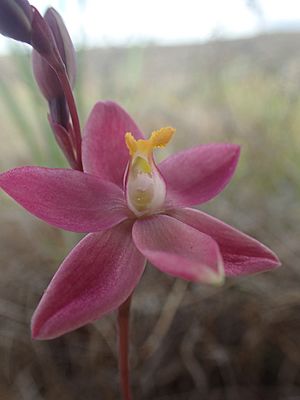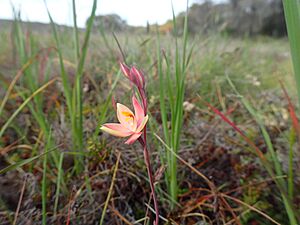Spotted curly locks facts for kids
Quick facts for kids Spotted curly locks |
|
|---|---|
 |
|
| Thelymitra maculata growing on Modesty Rock near Holt Rock | |
| Scientific classification | |
| Genus: |
Thelymitra
|
| Species: |
maculata
|
| Synonyms | |
|
|
The Spotted Curly Locks (Thelymitra maculata) is a special type of orchid. People also call it the Eastern Curly Locks. This beautiful flower grows only in the south-west part of Western Australia. It has one tall leaf that twists around its stem. The flower itself is pink or purple with cool spots. It also has yellow, ear-like parts on its central column.
What Does It Look Like?
The Spotted Curly Locks is a plant that grows from a tuber (like a small potato). It lives for many years. It has a dark green leaf that is egg-shaped at the bottom. The top part of the leaf is thin and often twists like a spiral. This twisted part can be about 3 to 8 centimeters (1.2 to 3.1 inches) long. It is also about 2 to 3 millimeters (0.08 to 0.12 inches) wide.
Each plant usually has one pink or purplish flower. The flower has irregular spots and is about 1.5 to 2.5 centimeters (0.6 to 1 inch) wide. It grows on a stem that can be 10 to 20 centimeters (3.9 to 7.9 inches) tall. The flower's sepals (outer parts) and petals (inner parts) are about 7 to 12 millimeters (0.28 to 0.47 inches) long. They are also about 3 to 6 millimeters (0.12 to 0.24 inches) wide.
The central part of the flower, called the column, is also pink or purplish. It is about 3 millimeters (0.12 inches) long. There are two yellow, ear-like parts on the sides of the column. These flowers can pollinate themselves. They usually open up on hot, sunny days. You can see them flowering in July and August.
How It Was Named
The Spotted Curly Locks was first officially described in 1949. A person named William Henry Nicholls gave it the name Thelymitra spiralis var. pulchella. He wrote about it in a science journal called The Victorian Naturalist.
Later, in 2009, Jeff Jeanes changed its name. He decided it was a full species and called it Thelymitra maculata. He published this new description in the journal Muelleria. The word maculata comes from a Latin word meaning "spot." This name refers to the spots you can see on the flower's sepals and sometimes its petals.
Where It Grows
The Thelymitra maculata orchid likes to grow in dry, open areas. You can often find it in heathlands or woodlands. It especially likes places near rock outcrops. This orchid grows in Western Australia. It is found in an area between Watheroo, Ongerup, and Hyden.
Is It Protected?
The Western Australian Government's Department of Parks and Wildlife has looked at the Spotted Curly Locks. They have classified it as "not threatened." This means it is not currently in danger of disappearing.


